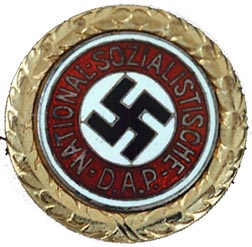
INTRODUCTION
The Munich firm of Joseph Fuess was one of the two makers of the smaller 25 mm version of the Golden Party Badge designed for civilian wear. (The so called "25mm version" actually measures 24mm.) For some reason, the Fuess version seems to be the type most frequently encountered of the small badges. Fuess did not make a larger 30.5mm version.
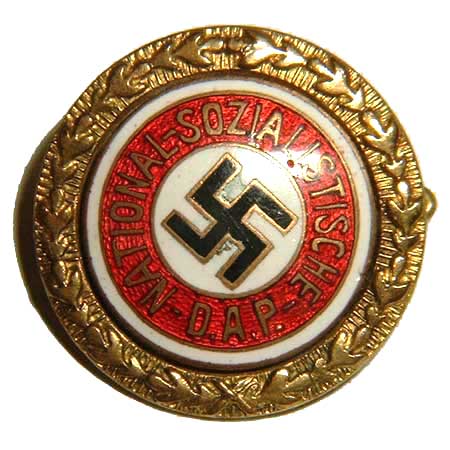 Jeweler
and medal maker Joseph Fuess is famous for also producing the first version
of the coveted Blood Order.
Jeweler
and medal maker Joseph Fuess is famous for also producing the first version
of the coveted Blood Order.
The 25mm version by Fuess is similar to the Deschler version with a few significant differences. It too had a smaller version of the standard enamel Nazi party membership pin at the center surrounded by a thin white enamel border and a golden oak leaf wreath (actually laurel leaves). The badge was fire gilded brass with the metal edges, letters and highlights in the enamel center silvered. As in the case of the larger version, frequently the silver plating of the letters wore off leaving the brass to show through underneath (as in the example to the right, which also shows a period repair to the enamel).
THE FACE OF THE BADGE
The wreath in the 25mm version by Fuess differs radically from the Deschler version.
The wreath only has seven leaves per side, but they are thinner and more stylized, and sit on a background of what one writer has called "railway ties", rays or ridges.
Lettering on the small Fuess badges is also distinctive. Letters tend to be unevenly thin, so that the "I" is spiky like a nail and the "H" in unusually thin. Other distinctive letters are an almost square "O" in SOZIALISTICHE and a "P" in "DAP" that also has a squareish top. Uniform, thick letters are indications of a fake badge.
Another significant difference between the Fuess and Deschler 25mm badges is that the silver border around the black enamel of the swastika does not touch the silver surrounding the red enamel of the wording in the Fuess badge, and there is a slight gap of white enamel.
In the Fuess version the hyphen or dash between "NATIONAL" and "SOZIALISTISCHE" also overhangs the "L" and almost touches the tail of the "S".
The red enamel should be translucent, and raised dots - which are more like short lines - should be visible underneath.
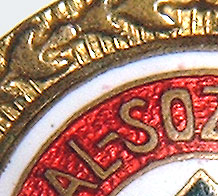 |
Examples
of the distinctive font used on genuine Fuess badges. The letter
"I" is almost like a spike, and the legs of the "H"
are very thin, almost ending in a point. As well, in originals the
"O" in SOZIALISTICHE is almost rectangular. The dash between
the "L"and the "S" almost touches the tail of
the "S".
|
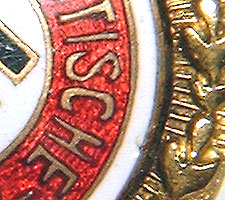 |
THE
REVERSE OF THE BADGE
An original Fuess 25mm Golden Party Badge is marked with the maker's name on the round pin plate:
MÜNCHEN
Something to watch for is that the "C" in Munchen should be round in originals, and not tall as seen in most recent fakes. Also, most originals have the maker's name not centered, but stamped slightly to the top and left corner of the pinplate.
Different from the way Deschler usually marked the reverse, the membership number in the Fuess version is stamped in a semi-circle to follow the contour of the bottom edge of the badge.
FAKES FROM THE 1980s
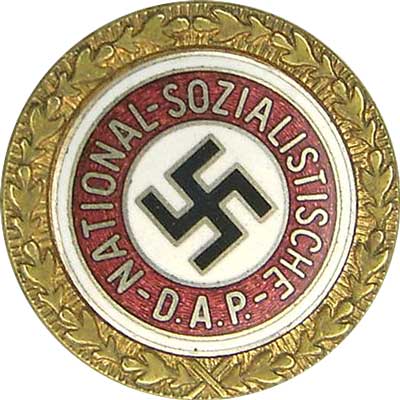 There
are a number of Fuess badges with thick and uniform lettering on the face
that have been regarded in some collecting circles as original. These
badges are now reported to have come out of Austria in the early to mid-1980s,
and at least one collector has reported purchasing them as acknowledged
fakes at that time from a dealer's large stock. An example of this reproduction
badge is shown to the right and can also be seen
here.
There
are a number of Fuess badges with thick and uniform lettering on the face
that have been regarded in some collecting circles as original. These
badges are now reported to have come out of Austria in the early to mid-1980s,
and at least one collector has reported purchasing them as acknowledged
fakes at that time from a dealer's large stock. An example of this reproduction
badge is shown to the right and can also be seen
here.
Although extremely well executed, another distinguishing feature is the reverse, which typically has repeating numbers (i.e. 66993) and a tall "C" on the pin plate in "MÜNCHEN" instead of a round one. The entire stamping of maker name and city on the pinplate is centered, where most originals have it stamped high and to the left.
This mistake on the pinplates has been repeated in the more recent and equally dangerous fakes that can be seen here, which appeared in about 2002.